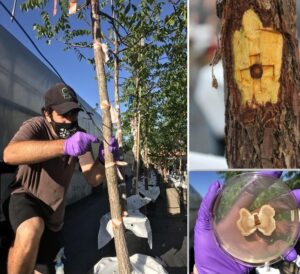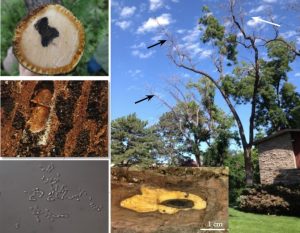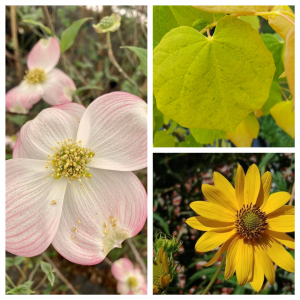Phytobiomes of Trees

Left: Black walnut (Juglans nigra); Top Right: Geosmithia morbida inoculations/transcriptome experiment; Bottom Right: Geosmithia morbida pure culture
Plant phytobiomes consist of a plant, its associated microbial communities, and the environment, all of which are integral to understanding plant-stimuli responses. We are investigating the host-pathogen-vector interactions of the Thousand Cankers Disease Complex (TCD) as a medium to examine host plant phytobiomes and their effects on disease severity in walnut (Juglans) species.
Host-Pathogen-Vector Interactions

Thousand Cankers Disease Host-Pathogen-Vector Complex. (Daniels et al. (2016) Forests, 7:260.)
Geosmithia morbida is the fungal, causal agent of Thousand Cankers Disease (TCD) along with its vector, Pityophthorus juglandis, the walnut twig beetle. Due to the complex coevolutionary history of G. morbida, we are utilizing this host-pathogen-vector complex as a model for identifying and assessing candidate genes and functions required for pathogenesis.
Conservation Genetics, Biodiversity, & Food Security

Frafra Potato (Solenostemon rotundifolius), Native Ghanaian Food Crop
In service of global forest stewardship, we primarily investigate the genetic variability and disease ecology of socially, economically, and ecologically important trees. However, we are also analyzing the population genetics of both endangered and endemic plant species facing habitat destruction from the US and Ghana to aid both conservation and global food security efforts.
Population Genetics

Ruth’s Golden Aster (Pityopsis ruthii), an endangered Tennessee endemic
Population genetics focuses on the study of genetic variability and patterns of gene flow within a species across its range. Thus, we are examining the influences of spatial fragmentation, host-pathogen interactions, and host-pathogen coevolution to elucidate the ecological and evolutionary history of genetic variability within species as a response to plant disease outbreaks.
Ornamental Genomics

Left: Flowering Dogwood (Cornus florida); Top Right: Redbud (Cercis canadensis) ‘Rising Sun’; Bottom Right: Whorled Sunflower (Helianthus verticillatus) (Credit: Sarah Boggess)
Our collaborative, ornamental genomics program focuses primarily on Flowering Dogwood (Cornus florida), Redbud (Cercis canadensis), Whorled Sunflower (Helianthus verticillatus), and Weigela (Weigela florida). We develop novel genomic and bioinformatic tools to elucidate the genetic underpinnings of phenotypic traits of interest for the horticultural industry, such as flower color and disease resistance, as well as to conserve the genetic variability of these species in the landscape.
Forest Genomics and Species Restoration

Green Ash (Fraxinus pennsylvanica). Top Left: Leaves; Bottom Left: Female Flowers and Swelling Leaf Buds; Right: Symptoms of EAB infestation.
In the last two decades, American Ash trees (Fraxinus spp.) have been devastated by the invasive, wood-boring beetle Emerald Ash Borer (Agrilus planipennis; EAB). Our lab is interested in characterizing and conserving the remaining genetic variability of Ash, as well as assessing traits for EAB resistance by combining genomic and bioinformatic tools with traditional landscape ecology.
Genomic Tools to Promote Sustainable Cacao Agroforestry

Top Left: Agroforestry system in Belize, BFREE (Belize Foundation for Research & Environmental Education). Top Right: Student assisting with pollinator collection. Bottom: Disease symptoms on a Criollo cacao leaf.
Cacao (Theobroma cacao), the primary ingredient in chocolate, is more than a treat. It is a vital source of income for more than 50 million people worldwide. However, cacao farming faces significant challenges. Fungal diseases and climate change severely impact cacao yields and the livelihoods of farmers.The team is studing the variability of fungal communites in Criollo cacao, an economically underutilized fine flavored cacao. The team is also studying genetic variability and pollinator activity of wild and cultivated cacao trees to provide insights for sustainable cacao agroforestry.